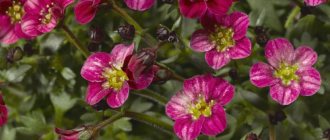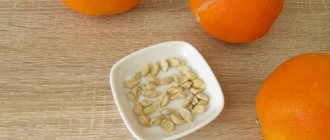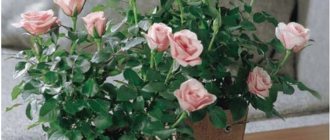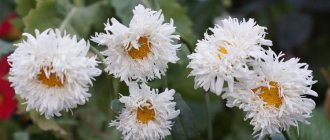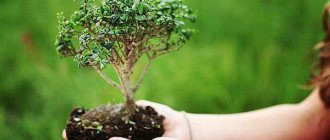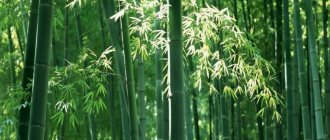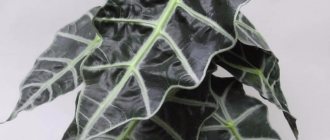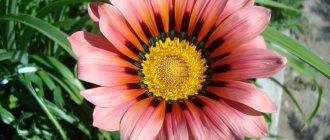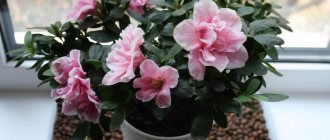You are in the Ferns , a large indoor section that contains the following plants: Pteris, Adiantum, Davallia, Asplenium, Platicerium, Nephrolepis.
Ferns have long been popular in indoor gardening. They are grown in greenhouses, flower beds, and special glass display cases.
They are planted in pots and placed on the territory of medical institutions, schools, pharmacies, offices, which makes non-residential space lively, presentable and original from the point of view of modern interior design.
Most representatives of the subsection are presented in the form of a rosette, which is formed by dissected arched leaves . Flower growers also distinguish ferns with small round-shaped leaves and lanceolate leaves. Many of them are ideal for flowerpots or hanging in other decorative vessels. Also popular are large varieties that look harmonious alone in square, round, or diamond-shaped floor flowerpots.
Is it possible to keep a fern at home?
There are many signs and superstitions associated with this mysterious plant. This plant is surrounded by mystery and mystery. According to legends, it is believed that if someone sees a fern blooming in the forest, then such a person will live a long and happy life. Is this really so, and why are there so many legends around this flower?
Signs and superstitions about ferns
Signs say that if an indoor fern grows in a house, its owner may find a treasure. Also, according to superstitions, owners of indoor ferns are guaranteed:
- harmony in family relationships;
- finding a common language between different generations;
- monetary wealth and financial well-being.
- protection from evil spirits.
But in addition to good signs, there are also negative ones:
- a fern in the house is an energy vampire and takes away strength from household members;
- owners of this plant often have headaches;
- fern brings misfortune.
Attention: ferns in the house can cause constant headaches in the morning, as they absorb large amounts of oxygen. It is not recommended to place it in the bedroom. This plant can also adversely affect allergy sufferers.
Davallia
dalliya - photo by the author
dalliya - photo by the author
Davallia grew with me for many years and died, most likely, from overwatering - I fell in love with it out of inexperience. Now I bought it again. The fern is unpretentious with funny hairy rhizomes that look like spider legs.
I advise those fern lovers who do not have room for large specimens to get a davallia. It needs very loose soil and careful watering.
I didn’t notice that she reacted negatively to the dry air in winter. Davallia - looks great in a hanging pot.
Indoor fern varieties: what are they, description and photo
It would seem that all ferns are the same. But in fact, there are more than 10 thousand different types of them. Let's look at popular types with names and photos of this plant that are suitable for growing indoors:
- Nephrolepis. Consists of 30 varieties. Ideal for breeding at home;
- Pelley. It is characterized by the unusual color of the dark green plates. By species it is divided into pellea spear-shaped, round-leaved;
- Polydomium. Rarely grown at home. Popular types of polydomium golden, pimply;
- Pteris Cretan. It occurs with curly, sword-shaped leaves.
Nephrolepis curly
Another variety that was created based on nephrolepis exaltata. It is characterized by dark green leaves that arise from rhizoids - small roots for attachment to the ground.
The fronds are long, about 60 cm in length, and consist of small plates, pointed in shape, with wavy edges. It is often grown at home; nephrolepis curly looks impressive when hung.
Where is the best place to put a plant at home?
The fern can be placed in any room except the nursery and bedroom. This is due to the fact that at night the plant releases carbon dioxide, which can lead to headaches in the morning.
In general, ferns in the house:
- absorbs toxins;
- humidifies the air;
- absorbs radiation from household appliances.
Therefore, it should be placed next to household appliances. But the plant cannot be placed in direct sunlight or in drafts.
Conclusion
Fern is a good house plant, and will even help purify the air in a city apartment, but it should only be planted by people who have enough time to regularly water and humidify the air near it. If you often have to leave your home for long periods of time, refrain from purchasing this plant.
The fern varieties listed in the article are only a part of those that can be kept in our apartments. Photos and detailed descriptions of other varieties of fern can be viewed on third-party professional resources, or in the relevant literature.
How to care for ferns at home
To create favorable conditions for indoor ferns, you need to take care of: lighting of the plant, air temperature, and conditions of maintenance. Let's take a closer look at how to care for ferns.
Lighting
The fern thrives in the shade. The plant should not be placed in direct sunlight. Sunlight must be diffused. To do this, it is recommended to adjust the blinds on the windows in such a way as to reduce a large amount of light. It is best to place the plant on a north window, as south and east windows let in too much light, which the fern does not like.
Temperature
Caring for ferns at home also comes down to creating the optimal temperature:
- in summer, ferns love air temperatures from + 20 to +25 degrees above zero;
- in winter the temperature can be reduced to +20...+15 degrees above zero.
Attention: ferns do not tolerate drafts. And because of this, they shed their leaves, losing their decorative effect.
Watering
The fern should be watered carefully. It does not like dry soil, but does not tolerate waterlogging. Watering is carried out with warm water without chlorine. To do this, you can use both purchased water and settled water from the tap or rain.
Humidity
Ferns love moist air. It is best to place a humidifier in the room with this plant. Or you can do it easier by placing the pot with the plant on a tray with water and expanded clay. The main thing is that the roots of the plant do not come into contact with water. Otherwise the flower will simply rot.
Original views for the garden
Garden ferns have a natural beauty and do not require shaping. Among them there are species that form thickets, some in the form of a bush, so you can choose varieties for rockeries, for creating an area of wild nature, for solitaire plantings.
Related article:
Unpretentious perennial flowers from seeds for the garden
Adiantum pedatum
A very elegant look for the open ground of the middle zone. The height of the spherical bush reaches 60 cm, the leaf is flat, light green, fan-shaped, pinnately dissected, sitting on a thin black petiole. The stem is flexible and shaped like a horseshoe. Winter hardiness is high - withstands frosts down to -35 ° C, shelter is not required.
Adiantum looks decorative from spring to frost, so it needs to be planted in a prominent place, in the front part of the flower garden. Looks elegant among stones, in rockeries, on terraces. Areas with loose, fertile, slightly acidic soil located in light partial shade are suitable. Loves moisture, but dies when water stagnates.
Asplenium or hair-like bone (Asplenium trichomanes)
A beautiful openwork plant with a peculiar smell, round-ovate, jagged, dark green small (10-20 cm) leaf. In cultivation, Kostenets is unpretentious, grows well in the shade of tall bushes and trees, and prefers alkaline soil. It grows quickly, forming graceful turfs that need to be divided every 3-4 years (preferably in the spring). Tolerates low temperatures well under a snow blanket.
Female stumpweed (Athyrium filix-femina)
The plant owes its name to its delicately dissected lacy leaf, which contrasts with the coarser leaf of the male fern. This is a tall (up to 1 m) rhizomatous perennial with large carved leaves of light shades of green, sitting on long petioles. The leaves form a beautiful rosette.
For the nomadic plant, choose an area protected from the winds and, preferably, in partial shade. In the sun, it lags behind in development, loses its decorative properties and does not grow higher than 60 cm. It grows for about 10 years without replanting, and reproduces by self-sowing and dividing the bush. The culture is unpretentious, frost-resistant, looks impressive with lilies, hostas, Rogers, kupena, and cereal grasses.
Related article:
Hazel grouse or fritillaria
Chinese nomadic grasshopper (Athyrium rubripes)
The variety is used to create group plantings between trees, bushes, a spectacular green corner in the garden, at the dacha, and to add originality to the flower garden. When grown outdoors, it requires sufficient moisture. Graceful reddish feathery leaves, collected in a bunch, give the site a unique flavor. In autumn the leaf dies. It tolerates frosts without loss.
Brown's polystichum braunii
One of the most original winter green species. A funnel-shaped beautiful rosette (height up to 0.6 m), extending from a powerful short rhizome, is formed by pinnate leaves narrowed at the base. It grows slowly and does not form thickets. It can be propagated by lateral shoots, which are separated from the top of the rhizome. Does not require transplantation for 20 years.
Male shieldweed (Dryopteris filix-mas)
The variety grows well in fertile, moderately moist soils and does not form thickets. In sunny open areas it becomes smaller and less decorative. According to legend, it is from the male shield plant that you need to see fiery flowers on Kupala night in order to learn about secret treasures and your future. The name “male” is associated with the rougher outlines of the leaves than those of the female fern.
Overwintering leaves from 20 to 80 cm long form a dense cup-shaped rosette with a height of 50 to 150 cm. The upper part of the plate is dark green, the color is lighter below. The growing season lasts from mid-spring to mid-autumn. Planted in groups of individual plants at a distance of 1-1.5 m from each other. Frost resistance is high.
Replanting an indoor fern
Beginner gardeners are interested in the question: how to replant indoor ferns? This is quite easy and simple to do. It is enough to prepare a new, larger pot, soil for ferns, and have some free time.
What kind of soil does an indoor fern need?
Ferns cannot be planted in ordinary garden soil. It needs special soil, which can be purchased at a garden store. You can also prepare it yourself from:
- soil;
- peat;
- humus;
- garden soil.
What kind of pot do you need?
The fern pot must be short and wide. This is due to the fact that its roots do not go deep into the pot, but are located almost on the surface. As for the materials for making a fern pot, experienced gardeners recommend choosing clay containers that absorb moisture well.
Fertilizer
Caring for ferns at home also comes down to applying fertilizers. Although some experienced gardeners believe that feeding this indoor plant is not necessary. But, if its leaves become small and lose color, then it is recommended to fertilize the flower:
- potassium salt;
- superphosphate;
- ammonium nitrate.
Attention: ferns are not fed with organic fertilizers, as they cause burns to their leaves and roots.
Features of transplantation
The plant is replanted as needed. But, as a rule, this must be done annually, since the plant grows at a rapid pace and becomes cramped in the pot. The fern is transplanted by transferring it to another pot. In this case, there is no need to remove the soil from the roots. Simply place the plant with a lump of earth in a larger pot and add soil.
Attention: if the plant is sick, then when replanting its roots are cleared of soil, treated with special preparations, and the plant is planted in new soil.
Fertilizer
Feeding the fern is not necessary, since it feels fine without it. If they become pale and small, this indicates a lack of nutrients in the soil.
The plant needs feeding during the period of active growth - late spring and summer. It is advisable to fertilize using liquid complex mineral compositions, for example a solution, 1 liter of which includes:
- potassium salt – 1 g;
- superphosphate – 1.5 g;
- ammonium nitrate – 1.5 g.
You need to use organic matter with caution, as it can cause burns. Some gardeners periodically add tea leaves to the pot or water with a weakly infused drink.
Reproduction
Let's look at how ferns reproduce:
- sowing spores;
- dividing the bush;
- shoots;
- lateral buds.
Attention: fern propagation by sowing spores is used extremely rarely, even by experienced gardeners.
As for dividing the bush, this method is used for species with a branched root system. In this case, the rhizome is simply divided into different parts (the main thing is that the rhizome contains heads, that is, attachment points for the leaves). It is recommended to separate areas with two shoots. And then the divisions are planted in pots.
The fern also reproduces by shoots in the form of arrows. It is enough to bend them into a container with soil and secure them. After some time, the shoot will take root and can be separated from the mother plant.
As for propagation by lateral buds, they are separated when the roots are formed. Young sprouts are transplanted into mini greenhouses, where the air temperature is maintained at least 23 degrees above zero. When the first leaves appear on the buds, the seedlings can be transplanted into separate pots.
Attention: only ferns of the following species reproduce by lateral buds: Adiantum, Pellea, Pteris.
Rules of care
After planting in open ground, decorative ferns build up their root system and gain strength within two years. During this period and in the future, it is important to follow the watering regime and not allow the soil to dry out - it should always be moist, but not soggy. If watering is insufficient, this will be noticeable by the small size of the bush, leaves, and early yellowing. After the earthen clod has completely dried out, not every plant is able to recover.
Ferns are rarely transplanted - they grow in one place for many years. If there is a need to change the location or the clump has grown greatly, then it is better to replant during the initial growing season (early spring). You can do this in the summer, if you can follow the watering regime. Otherwise, rooting may not occur.
Related article:
Lithodora for your garden: types, description and secrets of cultivation
The crop does not need fertilizing - powerful roots supply the plant with everything it needs. An additional source of nutrition can be mulch from peat, leaf and pine litter. As gardeners note, garden ornamental ferns have good immunity and are almost not susceptible to infections and pests.
Helpful information! Equipment needed for summer cottage work
Preparing for winter
Most species are frost-resistant and do not require shelter. But there are varieties that do not tolerate low temperatures well, so protection is built for them in the form of spruce branches, fallen leaves, and snow cover. Those that grow in flowerpots are brought indoors or transplanted into the ground in early autumn.
Fern diseases and pests
If you follow all the rules of agricultural technology, the fern will not be attacked by pests and will not get sick. But if favorable factors are not observed when growing a plant, you may encounter the following problems:
- yellowing, drying and dropping of leaves. This can happen due to watering the plant with cold water containing chlorine. Since, along with poor-quality water, the plant will be attacked by nematodes. The flower can only be saved by completely replanting it into a new substrate. The flower must also be treated with special insecticides;
- If the indoor air is too dry, the fern is attacked by aphids, scale insects, and thrips. Frequently spraying the plant with warm water can help avoid their appearance. But when pests appear, the fern must be treated with insecticides.
In conclusion, it is worth noting that despite the numerous superstitions and signs associated with this mysterious and mysterious plant, some gardeners still grow fern at home due to its high decorative value.
If you also want to plant a fern in your apartment, find out what types of ferns are suitable for this, how to properly care for the plant, and how to replant it. Subject to simple growing conditions, indoor types of ferns will delight owners with a neat, elegant appearance at any time of the year.
Blechnum humpback
blekhnum - collage by the author
blekhnum - collage by the author
I've turned this guy on more than once - I really like him. But for reasons unknown to me, he died, and very quickly. Since I still didn’t understand what was wrong, I won’t start it again.
Blekhnum prefers watering with soft water, abundant in summer, moderate in winter. Perhaps he didn't like our water. Calmly tolerates dry apartment air, does not like spraying. In winter it needs a cool temperature of +18° C.
By the way, this is a tree fern, and it develops a trunk over time. But since it died very quickly, I didn’t see any trunk. ????
